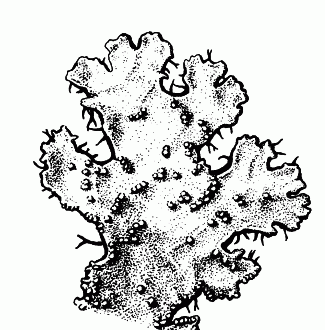Parmelia saxatilis (L.) Ach.
Pebbled crottle
Parmeliaceae
Introduction to the Lichens
Pebbled crottle
Parmeliaceae
Introduction to the Lichens
Map
Distribution of Parmelia saxatilis unavailable
Species Information
General:
Medium stratified foliose lichens, corticate above and below, sorediate or isidiate or not, checkered pseudocyphellate (in BC), lobes loosely attached to rather closely appressed, elongate, averaging to 1.5–10 mm wide, thin. Upper surface whitish or pale greyish blue, somewhat shiny. Lower surface blackening, shiny, bearing short or rather long, simple or branched rhizines. Medulla white. Photobiont green. Apothecia located over upper surface, disc brown; spores simple, ellipsoid, colourless, 8 per ascus. Over rock and trees.
Notes: Parmelia is primarily a boreal and temperate genus consisting of 39 species worldwide. Eight of these are reported for North America and seven occur in B.C. As originally circumscribed by Acharius in 1803, Parmelia encompassed an enormous assemblage of foliose lichens, including Lobaria, Pannaria and Xanthoria. Beginning in the latter half of the 19th century, and apparently concluding only in the past decade, lichenologists have divided Parmelia into dozens of new genera, most of which are now widely accepted. Local species accommodated until recently in Parmelia are now dispersed among the following genera: Ahtiana, Arctoparmelia, Flavopunctelia, Hypotrachyna, Melanelia, Neofuscelia, Punctelia, and Xanthoparmelia.
Species description:
Soredia and/or isidia present (rarely sparse); ecology various AND Thallus isidiate; isidia hard and shiny or occasionally with soft, cottony appearance but never associated with soralia AND Rhizines unbranched or at most sparsely forking/dichotomous; distribution various AND Isidia distinctly hard-corticate, often somewhat shiny, granular to long-cylindrical (in doubtful cases, check young isidia); medulla K- or K+ yellow becoming orange AND Lobes often rather loosely attached and overlapping; rhizines mostly unbranched; over rock (rare over bark); medulla K+ yellow becoming orange
Comments:
Included under Parmelia saxatilis are two rather distinct morphologies that may deserve separate taxonomic recognition. These are distinguished as follows: 1. Parmelia saxatilis - Upper surface pale bluish grey (brownish where exposed), generally pale or concave; pseudocyphellae in netlike patterns throughout; isidia generally originating in part over upper surface. 2. Parmelia sp. 1 - Upper surface greenish (but turning yellowish in herbarium), often convex; pseudocyphellae generally confined to area of lobe tips; isidia tending at first to arise along lobe margins (though later also developing over upper surface)
Reactions:
Cortex K+ yellow, medulla K+ yellow becoming red, PD+ orange to red.
Contents:
Atranorin, lobaric acid and salazinic acid.
Source: Lichens of British Columbia
Illustration

If more than one illustration is available for a species (e.g., separate illustrations were provided for two subspecies) then links to the separate images will be provided below. Note that individual subspecies or varietal illustrations are not always available.
Illustration By: Trevor Goward
Habitat and Range
Habitat: Common over acid rock in open sites throughout, also infrequent over conifers in open coastal forests; widespreadWorld Distribution: circumpolar.
Source: Lichens of British Columbia
Status Information
Synonyms
Synonyms and Alternate Names:
Parmelia kerguelensis A. Wilson